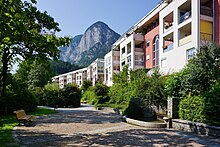Peerhofsiedlung
| Peerhofsiedlung ( settlement ) | ||
|---|---|---|
|
|
||
| Basic data | ||
| Pole. District , state | Innsbruck city (I), Tyrol | |
| Judicial district | Innsbruck (city) | |
| Pole. local community | Innsbruck ( KG Hötting ) | |
| Locality | Hötting | |
| Statistical district | Hötting | |
| Coordinates | 47 ° 16 '6 " N , 11 ° 20' 48" E | |
| height | 662 m above sea level A. | |
| Post Code | 6020 Innsbruck | |
| prefix | + 43/0512 (Innsbruck) | |
| Statistical identification | ||
| Counting district / district | Peerhofsiedlung (70101) | |
 Peerhof settlement seen from the airport |
||
| Source: STAT : index of places ; BEV : GEONAM ; TIRIS | ||
The Peerhofsiedlung (formerly Peerhöfe) is a location in Innsbruck in Tyrol with over 750 apartments, which were built by 13 architects and five housing developers by the mid-1990s. At the time of planning and construction, the Peerhofsiedlung was the largest urban expansion area in Innsbruck and had a major impact on further residential construction activity in Innsbruck.
Geography and location
The Peerhofsiedlung is located 2½ kilometers northwest of the city center above Innsbruck Airport , on the left slope of the Inn Valley , at the foot of the Nordkette at heights of 662 m above sea level. A. The Frau Hitt ( 2270 m above sea level ) and the Kleine Solstein ( 2637 m above sea level ) are above the Peerstein settlement .
The Peerhofsiedlung, together with the statistical districts ( census districts ), belongs to the Lohbachsiedlung (84.8 ha, 5009 inhabitants, 541 buildings) north of the airport , along with the buildings of the technical faculties of the University of Innsbruck , north of which is Hörtnagl's settlement (626.9 ha, 5290 inhabitants) , 879 building) with All Saints' Day to the district of Hötting West .
History, infrastructure and sights
From 1985 to 1990 the Peerhofsiedlung was built in the west of Innsbruck under the mayor Romuald Niescher and town planner Arnold Klotz , mainly by the architects Horst Parson together with Arno Heinz , Günther Norer and Peter Thurner ("Gang of Four").
The Peerhofsiedlung is named after the farm (Peerhof) that was demolished here in 1983.
traffic
Since January 2019, tram line 2 (December 2017 - January 2019: temporarily 3 ) has been connecting the Peerhofsiedlung to the city center and has completely replaced the former trolleybus line and later diesel bus line O. The Peerhofstrasse branches off from Viktor-Franz-Hess-Strasse and leads directly into the Peerhofsiedlung.
Waters
The western section of the Lohbach , which was renatured in 1988 and designed as a biotope, flows below the Peerhofsiedlung . Part of the water from the Lohbach is pumped into the pond in the Peerhofsiedlung, the overflow of which flows back into the Lohbach via a waterfall.
literature
- Arnold Klotz: The Peerhofsiedlung in Innsbruck: From an urban development concept to an urban development project. Springer Vienna, 1996, ISBN 978-3211828106 .
Web links
- 70101 - Innsbruck. Community data, Statistics Austria .
proof
- ↑ TIGEWOSI, Neue Heimat Tirol, WE - residential property, BUWOG , Alpine homestead.
- ↑ Innsbruck's urban development in book form , Innsbruck informs, May 11, 2016.
- ↑ City of Innsbruck: area, inhabitants and number of buildings of the individual census districts and statistical districts of the city of Innsbruck (as of April 2014) (PDF; 143 kB)
- ^ Court jester, tarred and feathered , Tiroler Tageszeitung , August 3, 2015.
- ↑ Other architects involved: Ernst Bliem, Helmut Grassberger, Peter Kirchmaier, Peter Leibetseder, Peter Lorenz, Peter Pontiller, Peter Swienty, Joachim Fanta (kindergarten) according to: Peerhofsiedlung , next room.
- ↑ Lohbach designed close to nature. School children also helped. In: Innsbrucker Stadtnachrichten, No. 7, 1988, p. 1 ( digitized version )
- ↑ Keep an eye on the natural jewel Lohbach. In: Innsbruck informs, June 2008, p. 12 ( digitized version )



